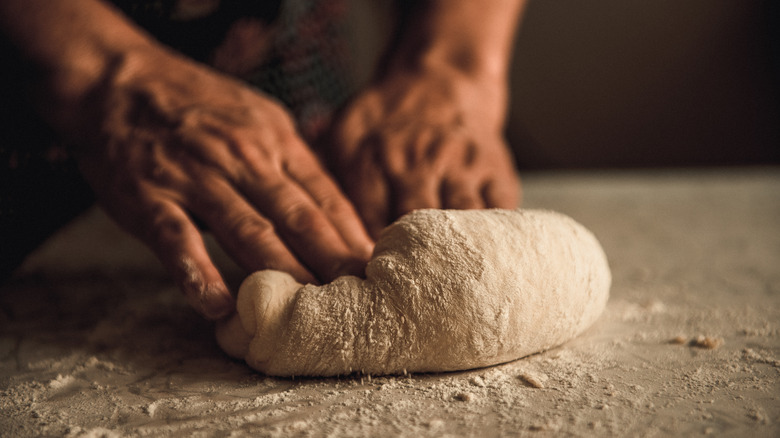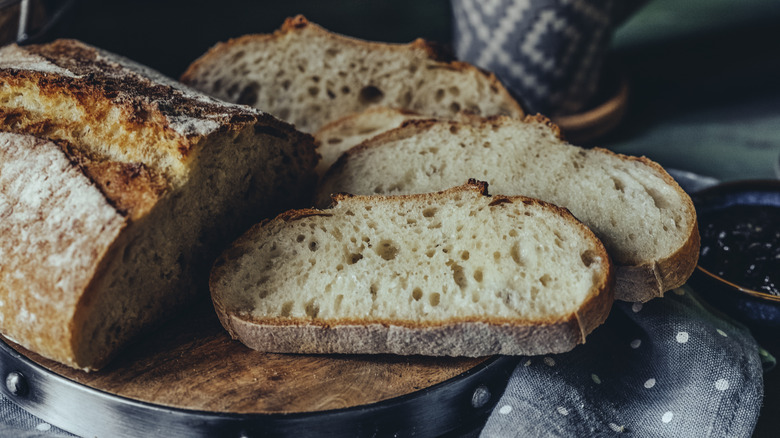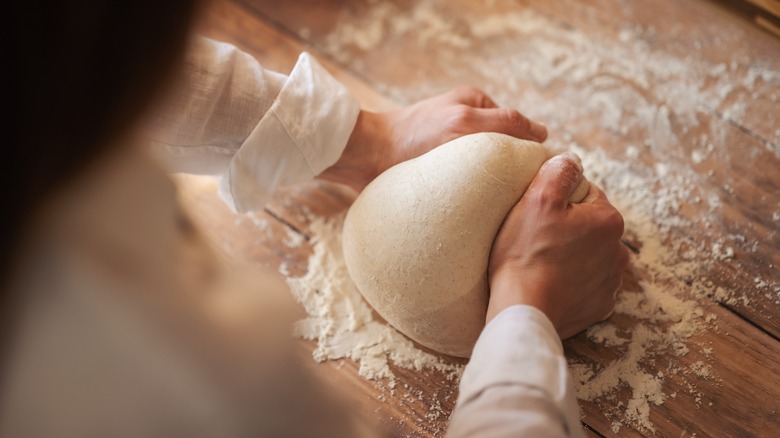The Kneading Mistake That Will Stop Bread From Rising
The act of baking bread may be the closest thing to alchemy that the real world has to offer. Transforming mere water and flour into a delectable boule or baguette is nothing short of magic, but the secret to the spell is remarkably simple. It's air. From the tight crumb of a loaf of sandwich bread to the big air bubbles in a sourdough batard, air is the secret ingredient that gives each style of bread its characteristic form and mouthfeel.
Air is typically incorporated into bread by baking with yeast (the exceptions are quick breads, which use other rising agents), and since yeast is a living organism, it can be very delicate to work with. This is particularly troublesome when it comes to kneading. Kneading your dough too much or too little can prevent your bread from rising to its full potential. In order to ensure a perfectly-formed loaf with the texture you're looking for, you need to get the kneading time just right, but that can look different depending on what style of bread you're making. Understanding the role that kneading plays in the bread-making process from the initial rise to the final bake will help you nail the perfect loaf every time, no matter what kind of bread you're after.
How kneading affects bread dough
The whole reason we knead bread in the first place has to do with gluten development. It's a common misconception that wheat flour contains a type of protein called gluten, but what it actually contains is two separate proteins — glutenin and gliadin — that, when mixed with water, combine to form the weblike network of molecules that we call gluten. Kneading helps to bring glutenin and gliadin together into sturdy strands that will ultimately provide structure to your loaf of bread. The friction generated through kneading warms up those gluten strands, improving their elasticity, which in turn determines how much the dough can stretch as it rises. The gluten network is also responsible for containing the gas let off by yeast.
Under-kneading your dough will prevent the necessary gluten network from forming. Since gluten is essentially the skeleton of bread, under-kneading will make your loaf fall flat, literally. The gas let off by the yeast needs a strong web of gluten strands to contain it, otherwise, your bread will end up dense, with hardly any air bubbles in it. On the other hand, over-kneading your bread dough can make the gluten strands so tough that the gas let off by the yeast won't have enough force to stretch them. The gluten will remain in a rigid state, and the loaf will turn out flat and tough to the tooth.
How to guarantee your bread will rise
To guarantee a perfect rise on your bread, you need to know the signs of a perfectly-kneaded loaf. Generally speaking, properly-kneaded bread dough should be smooth and barely sticky to the touch. If you poke it, the dough should spring back into place. You can also perform the windowpane test, trying to stretch the dough until it is thin enough to see light shining through (like a windowpane), at which point you know it's ready.
You can tell your dough is under-kneaded if it has a loose, shaggy texture and tears easily when you try the windowpane test. Fixing under-kneaded dough is easy: Just knead it more until you reach the right consistency. Over-kneaded dough is trickier. You can tell your dough is over-kneaded if it feels stiff and resists your attempts to stretch it. There's not much you can do to fix over-kneaded dough, but it's still worth baking the loaf. The dense texture will be lousy for toast and sandwiches, but if you tear it up and toast it in some olive oil, you'll get some pretty incredible croutons out of it.
If you find kneading to be a consistent hangup in your bread-making endeavors, don't lose hope. There are other methods of developing bread, such as the stretch-and-fold technique used in many sourdough recipes, which simply entails stretching the dough and folding it over itself in repeated intervals. Even easier, you can make no-knead bread dough, which takes longer, but is just about foolproof.


